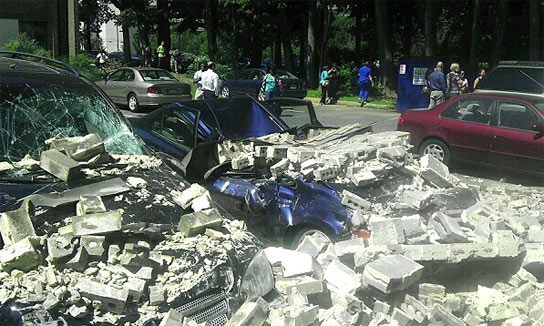
Collapsed walls after 2011 Virginia Earthquake

Seismicity of the coterminous United States and surrounding regions, 2009–2012. Black dots denote earthquakes with a magnitude ≥ 3.0 are shown; larger dots denote events with a magnitude ≥ 4.0. Background colors indicate earthquake hazard levels from the U.S. National Seismic Hazard Map (NSHM). Learn more about the NSHM at http://earthquake.usgs.gov/hazards/?source=sitenav.
The number of earthquakes has increased dramatically over the past few years within the central and eastern United States.
More than 300 earthquakes above a magnitude 3.0 occurred in the three years from 2010-2012, compared with an average rate of 21 events per year observed from 1967-2000.
This increase in earthquakes prompts two important questions: Are they natural, or man-made?
And what should be done in the future as we address the causes and consequences of these events to reduce associated risks? USGS scientists have been analyzing the changes in the rate of earthquakes as well as the likely causes, and they have some answers.
USGS scientists have found that at some locations the increase in seismicity coincides with the injection of wastewater in deep disposal wells. Much of this wastewater is a byproduct of oil and gas production and is routinely disposed of by injection into wells specifically designed and approved for this purpose.
Review Article on Injection-Induced Earthquakes
U.S. Geological Survey geophysicist William Ellsworth reviewed the issue of injection-induced earthquakes in a recent study published in the journal Science. The article focused on the injection of fluids into deep wells as a common practice for disposal of wastewater, and discusses recent events and key scientific challenges for assessing this hazard and moving forward to reduce associated risks.
What is Induced Seismicity?
Although it may seem like science fiction, man-made earthquakes have been a reality for decades. It has long been understood that earthquakes can be induced by impoundment of water in reservoirs, surface and underground mining, withdrawal of fluids and gas from the subsurface, and injection of fluids into underground formations.
http://www.usgs.gov/blogs/features/usgs_top_story/man-made-earthquakes/?from=title



